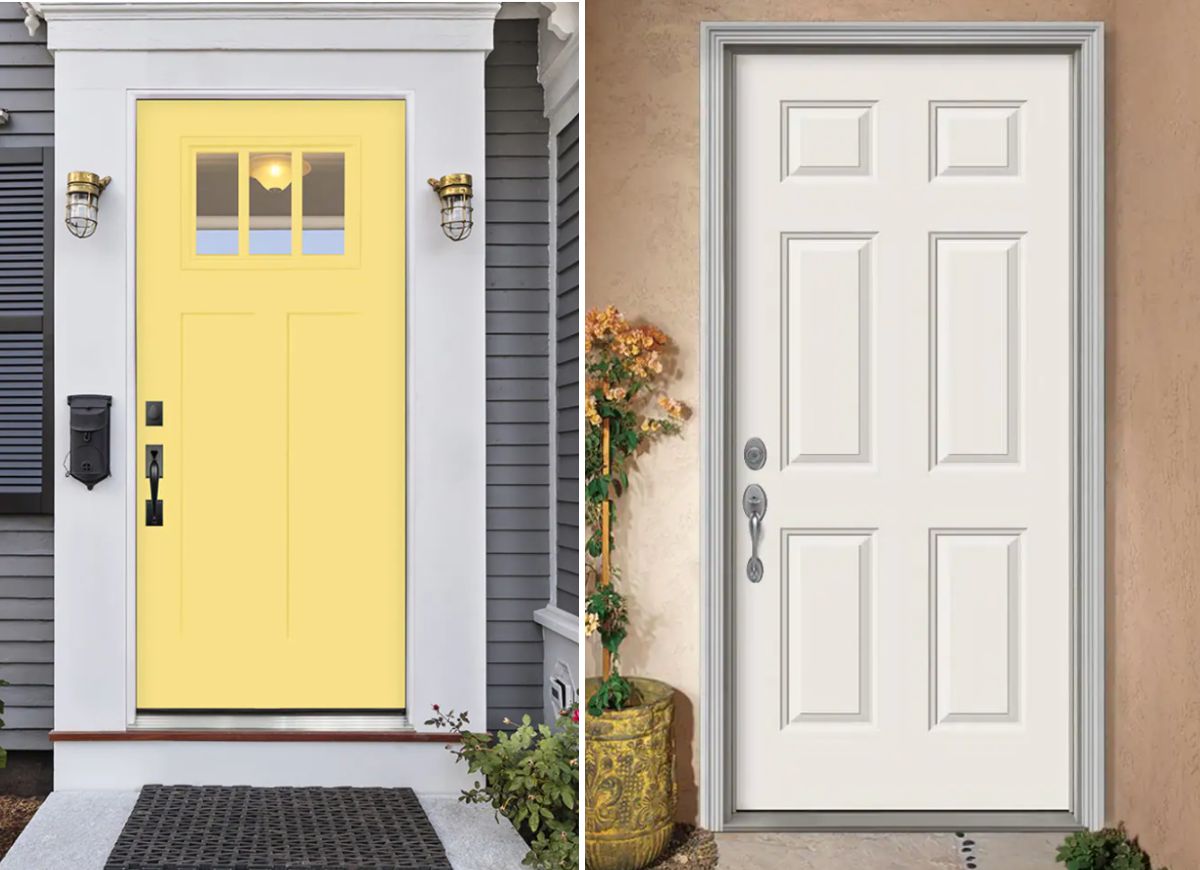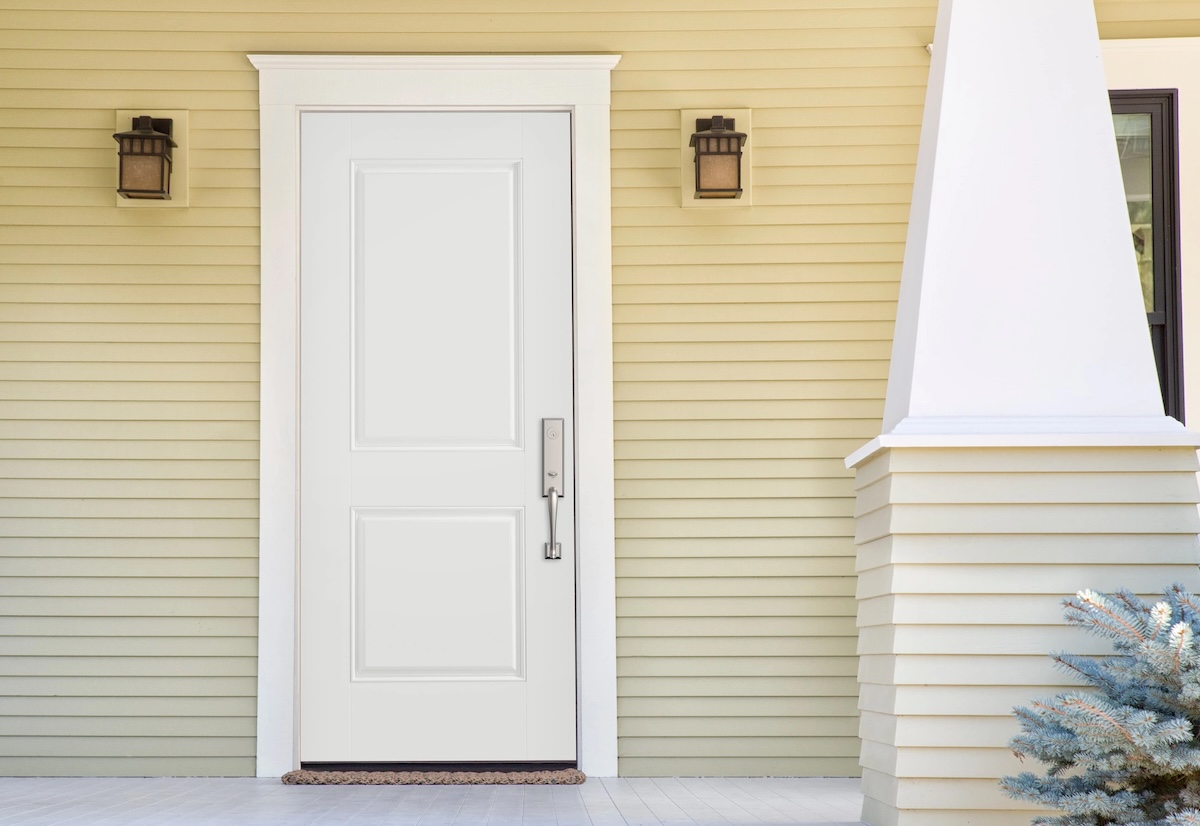

We may earn revenue from the products available on this page and participate in affiliate programs. Learn More ›
The front door is more than just an entry portal, it’s a key part of your home’s first impression. It sets the tone for your exterior design, adds personality, and can even boost curb appeal and resale value. But beyond aesthetics, it plays a critical role in home security, energy efficiency, and everyday comfort, so choosing the right front door is important.
Two of the most popular options for entry doors today are fiberglass and steel. Each material offers its own set of strengths when it comes to durability, insulation, maintenance, and price. In this guide, we’ll break down the pros and cons of fiberglass vs. steel doors to help you decide which one is the better fit for your front door.
Pros and Cons of Fiberglass Doors

Pros
- Durable and resistant to dents, rust, and corrosion
- Low maintenance compared to wood or metal options
- Energy-efficient with good insulation properties
- Can mimic the look of real wood without the upkeep
Cons
- Higher upfront cost than some steel doors
- May crack under extreme impact
- Limited ability to be resized or trimmed
Pros and Cons of Steel Doors

Pros
- Typically more affordable than fiberglass
- Excellent strength and security
- Fire-resistant and long-lasting with proper care
- Slim profiles available for a sleek, modern look
Cons
- Prone to dents, scratches, and rust over time
- Not as energy-efficient unless insulated
- Can feel cold or industrial in appearance
Fiberglass vs. Steel Front Doors
There are advantages to both fiberglass and steel doors, but the right choice depends on your specific needs and priorities. Here’s how they compare in terms of material, cost, security, energy efficiency, style, and maintenance.
Material
Unlike the classic solid wood door styles, both steel and fiberglass doors are constructed in layers. Both of them typically start with a core of either wood or polyurethane insulating foam, which helps with soundproofing and energy efficiency. From there, though, they differ significantly.
One key difference between fiberglass and steel doors lies in their outer shell. The exterior of a steel door is made of heavy-gauge galvanized steel, while fiberglass doors have a high-impact compression-molded fiberglass shell.
In the age-old debate of steel vs. fiberglass exterior doors, it’s worth noting that each type has advantages. Fiberglass can mimic the look of various wood grains. It’s customizable, low-maintenance, and weatherproof. Steel tends to be more affordable. What it lacks in custom design choices, it makes up for in strength and security.
Cost
Steel doors typically cost less to purchase and install than fiberglass or solid-wood doors. The size and weight of a steel door factors into the cost, and a purchase price of $1,300 isn’t unusual, but the average is more often between $200 and $1,000.
One of the disadvantages of fiberglass doors is that they can be more expensive. Quality and customization can add to the price, with high-end options reaching upwards of $3,000.
Properly maintained steel doors can last 30 to 100 years, and offer a return on investment of up to an impressive 188 percent, according to the Remodeling 2024 Cost vs. Value Report. Well-maintained fiberglass doors last only 15 to 20 years, with an average ROI of only 77 percent.
Security

When it comes to improving door security, it’s hard to beat steel—literally. Hit vigorously, steel doors may dent, but will rarely break or warp. Since it is nearly impervious to damage by force, steel is one of the strongest and best front doors for security.
Fiberglass, on the other hand, is a lightweight material that can fracture when impacted with extreme force, rendering it more vulnerable. Both steel and solid-wood doors offer better protection against break-ins.
Energy Efficiency
One of the biggest advantages of fiberglass doors is the cost savings they provide, thanks to their energy efficiency. Fiberglass doesn’t expand and contract like some materials, thus providing better insulation throughout seasonal changes. Some fiberglass doors are so energy-efficient, they have earned an Energy Star rating and qualify for tax credits.
While metal is known to transfer both heat and cold, the insulating core of today’s steel doors puts them on a near-equal footing to fiberglass when it comes to insulation value. For example, according to the U.S. Department of Energy, windowless steel and fiberglass doors both have an energy rating between R-5 and R-6 or higher. In comparison, windowless wood doors typically have an R-value somewhere around R-2 to R-3.

Tried-and-True Advice
“When I installed my first fiberglass door, I didn’t think much about the threshold. Big mistake! I ended up with a slight gap at the bottom, and that turned into an annoying draft come winter. After that, I used an adjustable threshold on my next door install. They make it so much easier to get a tight seal at the bottom, which helps keep out both cold air and water. If you’re tackling a door installation yourself, it’s definitely worth the extra investment.”
—Paul Rankin, Contributing Writer and Editor
Style
Today’s fiberglass doors offer a greater range of designs compared to steel, and can achieve a wood look that’s nearly indistinguishable from the real thing. Opting for stain rather than paint can further pronounce the wood-grain texture. Metal doesn’t provide quite the same illusion, as small dents and dings can give away the material. And if the galvanized coating wears off or is scratched, ensuing rust is a telltale sign that the door is not wood.
Homeowners often choose fiberglass to integrate windows and add more natural light to their entryway. Steel doors can come with windows, too, but it lessens the material’s advantage when it comes to security.
Maintenance
Neither fiberglass nor steel doors require a lot of maintenance. Basic care of fiberglass doors includes periodic wiping down or hosing off. The finish on fiberglass doors can fade over time due to sun exposure, so repainting or re-staining fiberglass doors is necessary from time to time. But because fiberglass doors don’t dent, warp, or decay, they’re a good option for high-traffic doorways.
Metal doors usually come from the factory with automotive-grade paint. To prevent corrosion, a front steel door should receive an annual application of linseed oil or car wax. If scratched, dented, or worn, a font steel door will rust unless repainted immediately.
